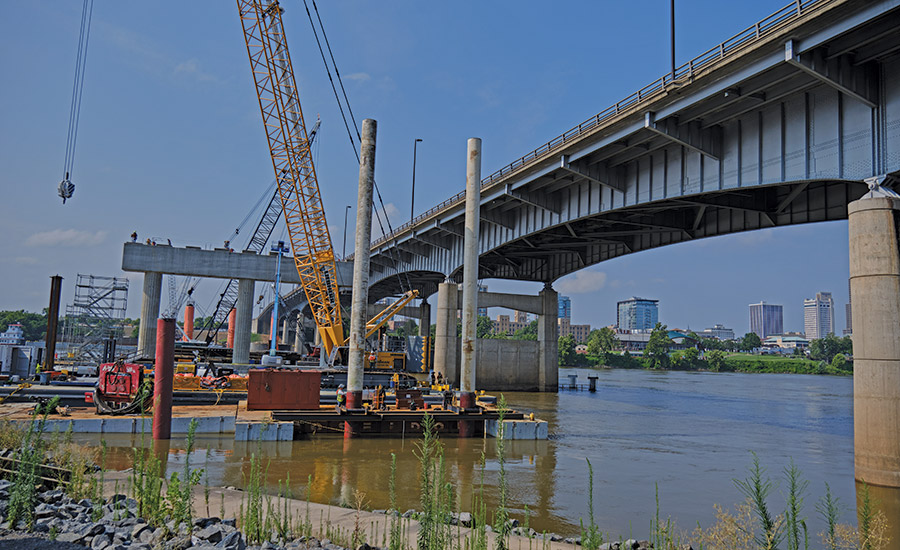In 2021, slowdowns in the regional oil and gas market as well as global supply chain delays impacted design companies doing business in Arkansas, Louisiana, Mississippi, Oklahoma and Texas. A robust start to 2022 has the industry anticipating better times.
The 50 largest firms on ENR Texas & Louisiana’s 2022 Top Design Firms ranking posted combined revenue of $6.32 billion for 2021, slightly short of the 2020 total of $6.48 billion.
Some of the leading architectural and engineering companies also saw regional revenue drop in pandemic-impacted 2021. Kansas City, Mo.-based Burns & McDonnell, which was ranked No. 5 on the list, saw regional revenue reach $324.9 million in 2021, a 17.25% decline compared with 2020.
The oil and gas downturn in 2020 continued into 2021 and resulted in a 56% decline in year-over-year design revenue from the company’s petroleum projects in Texas and Louisiana, says Leslie Duke, president and general manager for the Houston regional office. “In 2020, certain oil and gas clients put our projects on hold or canceled them altogether given the unfavorable market conditions at that time,” she explains.
Related Link:
ENR Texas & Louisiana Top Design Firms 2022
Similarly, HDR, which was ranked No. 7, posted a drop in regional revenue of 5.7% in 2021 to $216.31 million. “A large transportation client in the market slowed projects in 2021 due to rates of spending potentially exceeding budget limitations,” says Kelly Kaatz, HDR’s south central regional operations director, based in the Austin office. “This affected our overall revenue in the short term. However, those projects were restarted in late 2021 and continue into 2022.”

The Project Connect System Plan in Austin includes two light rail lines, a zero-emissions fleet and an expanded bus system. HDR is working with the Austin Transit Partnership.
Image courtesy of HDR
Gensler, ranked No. 18, experienced a 9.7% drop to $135.4 million in 2021. “Like many companies across the country and the world, Gensler was impacted by the pandemic,” says Judy Pesek, regional managing principal for the company. “However, we have successfully rebounded, and our project work is back to pre-pandemic levels, especially as the cities and communities where our Texas offices are located continue to experience record level growth and development.”
North Little Rock, Ark.-based Garver, which was ranked No. 14, raised its regional revenue 6.6% in 2021 to reach $161.1 million. “I think the biggest measure of Garver’s success was our ability to achieve significant organic growth in 2021—a trend that is still going strong in 2022,” says Frank McIllwain, senior vice president and director of aviation. “Our culture has allowed us to successfully retain and recruit employees in a competitive job market.”
Meanwhile, the company grew substantially in the aviation and transportation sectors, he says. “And while that has outpaced the industry, we’ve experienced even more tremendous growth in the drinking water and wastewater markets throughout the region.”

Indoor and outdoor spaces are blended into a cohesive experience at the University of Texas Moody Center Basketball and Events Arena in Austin.
Image courtesy of Gensler/Ryan Conway
Energy, Infrastructure Transformations
Particularly strong sectors for Burns & McDonnell in 2022 are data centers, transmission and distribution infrastructure and renewable energy. “As traditional oil and gas customers look to expand their renewable portfolios, we’re also starting to see them adding renewable power such as solar and wind to their portfolio as they evaluate electrifying their assets,” Duke says.
In November 2021, the company completed the 65-MWdc/50-MWac solar project at Vistra’s Brightside Solar Facility in Live Oak County, Texas. The competitively bid fast-paced project had more than 250 craft construction professionals on site at peak; it was delivered with zero safety recordables and no lost-time incidents, she says.
Currently, Burns & McDonnell is designing and building a $40-million lunar production and operations center at the Houston Spaceport for Intuitive Machines, which plans to be the first private company to travel to the moon. Scheduled for completion in 2023, the center will occupy 12.5 acres with more than 105,000 sq ft of office and advanced production space.
“Our design approach focuses on creating business and recreational
spaces for people that are fully accessible, inclusive and supportive of health and wellness.”
—Judy Pesek, Regional Managing Principal, Gensler
Duke adds that Texas is well primed to be a hub for bitcoin mining facilities: “These facilities have a wide range of needs in order to set up shop that include services in power, water, environmental and fiber optics design and construction.”
Garver has been focused on infrastructure. Since Congress passed the $1.2-trillion Infrastructure Investment and Jobs Act (IIJA) in 2021, clients have asked the firm for assistance in understanding the legislation and maximizing the opportunities it provides, McIllwain says.
In addition, Garver has created an alternative delivery group to ensure that clients are aware of these contract alternatives. “We’ve also expanded the scope of our innovative project controls team that provides clients with the independent and timely data necessary to make informed and strategic decisions regarding scheduling, scope, risk management and cost,” he says.
Among the company’s recent and current infrastructure projects is the DFW International Airport Runway 17L-35R Rehabilitation completed in April at Dallas-Fort Worth International Airport, a $1.2-million project that included comprehensive pavement rehabilitation and repairs to the existing stormwater infrastructure within the runway environment. Another is the $725-million 30 Crossing for the Arkansas Dept. of Transportation to establish a preferred schematic for alternative project delivery procurement documents and to develop the technical provisions and requirements for the company’s first design-build project, scheduled for completion in July 2025. Garver is also providing engineering inspection services that will replace the Arkansas River Bridge and provide safer and more efficient travel through the state’s largest metro area.
More than two years after the beginning of the pandemic, Gensler’s research shows that people want to come back together, but they want to return to environments that are lifestyle-oriented. “As a result, our design approach focuses on creating business and recreational spaces for people that are fully accessible, inclusive and supportive of health and wellness,” Pesek says.
Clients are also requesting these features for data centers; industrial/warehouses; mixed-use business campuses; office buildings and repositioning projects; residential/multifamily housing; sports and entertainment venues; and workplace interiors, she adds.

Vistra’s Brightside Solar Facility in Live Oak County, Texas, utilizes 440-watt First Solar thin-film modules in conjunction with a single-axis tracking system.
Photo by Bryan Fairbanks for Burns & McDonnell
Concerns, Trends, Forecasts
Despite enthusiasm for the infrastructure act bounty, Garver’s McIllwain is concerned about the implementation of the massive IIJA program, particularly whether the federal government can administer and distribute infrastructure funding packages at a pace that parallels the A/E/C industry’s capacity to deliver projects.
Burns & McDonnell’s Duke is concerned with price escalation and supply chain disruptions, including increased lead times and freight costs as well as the unpredictability of securing imported equipment and materials. “A big challenge for us this year will be mitigating those risks and supply chain constraints,” she says.
Because the pandemic has accelerated home delivery and online ordering services, the supply chain itself will change. “Long-term industries like shopping/retail, mission-critical, warehousing/logistics, data centers, food-consumption habits, online streaming services, broadband and more will be changed forever,” she says.
Duke also believes the continued movement to sustainability and decarbonization and massive investments in renewable energy will most likely revive the need for nuclear energy and create a long-term justification for hydrogen assets. “Energy storage isn’t robust enough currently to bridge us to carbon neutrality. And, with our transportation fleets moving to more electrification, that will put more stress on our generation and electric delivery infrastructure,” she says.
“Our culture has allowed us to successfully retain and recruit employees in a competitive job market.”
—Frank McIllwain, Senior Vice President and Director of Aviation, Garver
HDR’s Kaatz is concerned about recruiting and retaining talent for large projects, supply chain issues of key equipment components and materials and construction cost estimating and budgeting in a fluctuating economy.
Still, optimism is predominant. The transportation market continues to grow rapidly, with an increase in project funding by state departments of transportation, he says. Federal funding has also spurred the increase in large transit, port expansion and flood-hazard-reduction projects along the Gulf Coast. One such HDR project is Project Connect in Austin, a multibillion-dollar transit network being planned and implemented for the Austin Transit Partnership.
Kaatz says the high-tech/semiconductor industry market has dramatically increased as the U.S. resolves to regain chip manufacturing dominance. In addition, large projects such as the recent $17-billion fabrication facility for Samsung in Taylor, Texas, scheduled for completion in 2024, are also resulting in significant infrastructure investment for water and wastewater, power and transportation networks. The $4.9-billion I-35 Capital Express Central Project for the Texas Dept. of Transportation, which includes an expansion of I-35 in central Texas through downtown Austin, is in the planning stage.
At Gensler, “We are keeping an eye on interest rates and inflation and the potential impacts on the commercial real estate market,” Pesek says. “Our other priority is continuing to recruit and retain top talent in a very competitive job market.”





Post a comment to this article
Report Abusive Comment